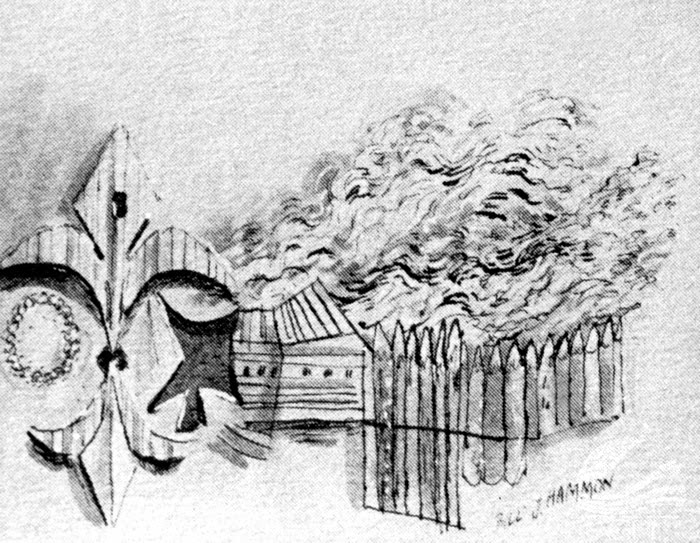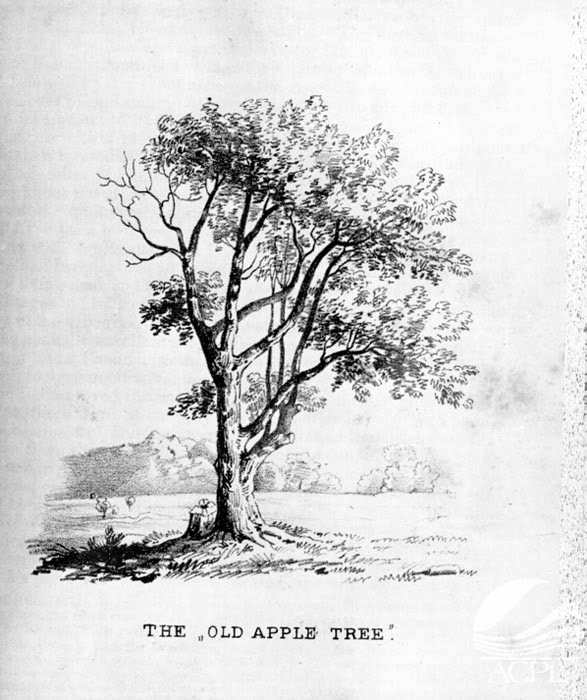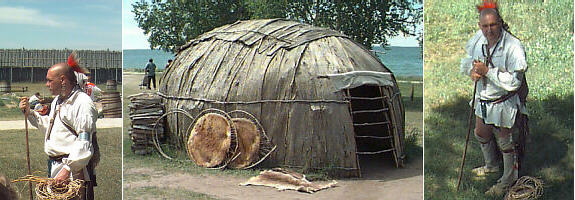

The centuries old struggles between the european powers had carried over to the new world. The same mistrust between the French and English had not stopped at the Atlantic Ocean. The new "twist" on this conflict was the pratice of using the native Indians to gain influence over certain territories. When the French started their exploration of the northwest they encountered the Miami Indians in the upper Great Lakes region. The Iroqious Indians, armed by the British,had pushed the Miami out of their homeland around the three rivers area. The French began trading relations with their displaced friends. The French, wanting to control the portage between the Wabash and St. Marys Rivers, needed to return their new trading partners to the area. The French envisioned a string of forts from Quebec to St. Louis making up a great French "wilderness empire". The British-backed Iroqious could not be trusted trading partners. Therefore, the French helped the Miami push out the Iroqious by arming them with French munitions. Various treaties were signed between the tribes, and the Miami were finally back in control of the portage and surrounding three river area. A new era of prosperity had begun for the Miami nation.
With the arrival of the Miami back in their homeland came the building of a great village called Kekionga. Meaning "blackberry patch" because of the abundance of blackberries in the area,it was said that Kekionga was a fortified villiage made up of huts surrounded by palisades spirialing to an entrance. At the center of this village was a great fire pit used for various types of ceremonies. The village became the center of the Miami nation and its source of strength. Trade at Kekionga began to thrive with an abundance of beaver fur in the area. The French also brought in the first missionaries seeking to convert the barbaric Indians to Christianity.
Before a French presence could be secured, they needed to insure Indian loyality. The French government dispatched a man by the name of Jean Baptiste Bissot,Lord of Vincennes to secure a solid trading relationship. In or around 1706 a trading post was built at Kekionga. The French built a trusting relationship with the Miami as they share many of their customs. With growing concerns of a British, the French establishing a more permanent military presence to secure their trade routes. A garrison was needed close enough to the Portage, but not far from Kekionga.
Fort Miamis or Fort St. Philippe was constructed in 1722 on the banks of the St. Mary's Rivers near what is today Guldin Park. Captain Dubuisson,a former commander of Detroit built and fortified the garrison to keep out any British encroachment. The Miami allowed the French use of the Portage route in exchange for pelts of beaver and other goods. This relationship florished for about a decade. Soon, the influences of the British started to show. British rum was cheaper to obtain than French brandy. The British seemed to have better goods and cheaper barter. The French tried to subdue the British by raiding and destroying their encampments, but this was not to help. With the help of the British, Chief La Damoiselle of the Miami led an attack on Fort St.Philippe. The Chief ordered the palisades burned to the ground and captured the remaining soldiers stationed inside. Most of the garrison managed to escape. It is said that a French solider's daughter drown while trying to escape. In the panic her canoe capsized trapping her underneath. It was a tragic betrayal bestowed upon the French who had trusted their Indian allies. This only convinced the French that the three rivers were worth the fight. It was important to reestablish a relationship with the Miami to keep hold of the portage.
In 1750, a new fort was built along the east bank of the St. Joseph river where St. Joe Boulevard and Delaware Avenue intersect. At this time most of the Miami had move east to Pickawillany (central Ohio)to trade with the British. Captain DeRaymond had completed the new fort and the garrison was filled with soldiers. Indians and fur traders began returning to the three rivers area. An outbreak of small pox in the Ohio Valley area reduced the population, and the remaining Indians and traders migrated to Kekionga. One of these traders,Joseph Drouet de Richardville, would have a major impact on the future of the Miami Indians. Richardville would make his fortune in the fur trading business and go on to marry Tacumwa, daugther of the Miami Chief. Their son, Jean Baptist de Richardville would be instrumental in the land negotiations in the early 1800's.
It was not long until the French and British hostilities led to war. When the French and Indian War broke out in 1755, Fort Miami became a focal point. Many of the French and Indian raids on the British forts farther east originated from the French outpost. Soldiers sent from Fort Miami helped in many battles including the defeats of both George Washington at Fort Necessity and British General Braddock at Fort Duquesne(Pittsburgh). Early in the War the French and Indians were driving the British back and taking control of the frontier. These successes were not to last. The British hit hard into the southern reaches of Canada. Both Quebec and Montreal fell to the British in 1759. Forts Detroit,Green Bay, and Michilimackinac surrendered to the British as well. The following year Fort Miami at the headwaters of the Maumee River fell to the British. The reign of the French "wilderness empire" was over. The Miami Indians had to contend with a new neighbor, the British.
Lieutenant John Butler and his British Rangers seized control of the Fort in November of 1760. Butler eventually gave command of the garrison over to British Ensign Robert Holmes. The British were not as patient with their Indian neighbors, and relations began to sour. Broken treaties and trade disputes eventually caused the Indians all over the Great Lakes region to unite under one leader. Chief Pontiac ordered the attack of all British garrisons north of the Ohio. On May 25, 1763 Ensign Holmes was killed by Indian musket fire which signaled the fall of Fort Miami. It is said that Ensign Holmes was in love with a local Indian girl. The Indians lured Holmes out of the Fort by telling him that the girl was gravely ill. He left the safety of the Fort to tend to her needs. The Indians ambushed and killed Holmes in the process. Further accounts suggest he was scalped as well. It would be three decades before Americans would build Fort Wayne ,claiming the three rivers permanently.








